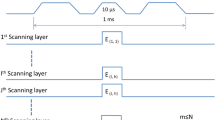Abstract
A proton therapy (PT) facility with multiple treatment rooms based on the superconducting cyclotron scheme is under development at Huazhong University of Science and Technology (HUST). This paper attempts to describe the design considerations and implementation of the PT beamline from a systematic viewpoint. Design considerations covering beam optics and the influence of high-order aberrations, beam energy/intensity modulation, and beam orbit correction are described. In addition to the technical implementation of the main beamline components and subsystems, including the energy degrader, fast kicker, beamline magnets, beam diagnostic system, and beamline control system are introduced.















Similar content being viewed by others
References
E. Pedroni, D. Meer, C. Bula et al., Pencil beam characteristics of the next-generation proton scanning gantry of PSI: design issues and initial commissioning results. Eur. Phys. J. Plus 126, 66 (2011). https://doi.org/10.1140/epjp/i2011-11066-0
J.M. Schippers, Beam-transport systems for particle therapy, CERN yellow reports: school proceedings, Vol. 1, CERN-2017-004-SP, p. 241, https://doi.org/10.23730/CYRSP-2017-001.241
B. Qin, W. J. Han, X. Liu et al., Design and development of the beamline system for a proton therapy facility, In: Proceedings of IPAC2019, Melbourne, Australia, (2019), THPMP017
B. Qin, W. Chen, X. Liu et al., Design of Gantry beamline for HUST proton therapy facility. IEEE Trans. on Appl. Supercond. 28, 4400205 (2018). https://doi.org/10.1109/TASC.2017.2772868
U. Rohrer, PSI graphic transport framework, based on a CERN-SLAC-FERMILAB version by K. L. Brown et al., (2007), http://aea.web.psi.ch/Urs_Rohrer/MyWeb/trans.htm
M. Berz, K. Makino, COSY INFINITY 10.0 Beam Physics Manual, (2017)
Opera-3D reference, http://www.operafea.com
J. Allison, K. Amako, J. Apostolakis et al., Recent developments in Geant4. Nucl. Instrum. Meth. A 835, 186–225 (2016). https://doi.org/10.1016/j.nima.2016.06.125
Z. Liang, K. Liu, B. Qin et al., Design and optimization of an energy degrader with a multi-wedge scheme based on Geant4. Nucl. Instrum. Meth. A 890, 112–118 (2018). https://doi.org/10.1016/j.nima.2018.01.073
F. Jiang, Y.T. Song, J.X. Zheng et al., Energy loss of degrader in SC200 proton therapy facility. Nucl. Sci. Tech. 30, 4 (2019). https://doi.org/10.1007/s41365-018-0526-6
W. Chen, J. Yang, B. Qin et al., Transmission calculation and intensity suppression for a proton therapy system. Nucl. Instrum. Meth. A 881, 82–87 (2018). https://doi.org/10.1016/j.nima.2017.10.047
A. Koschik et al., Gantry 3: Further development of the PSI PROSCAN Proton Therapy Facility, Proceedings of 6th IPAC, Richmond (USA), (2015)
Z.F. Zhao, B. Qin, X. Liu et al., Influence of fringing field and second-order aberrations on proton therapy gantry beamline. Nucl. Instrum. Meth. A 940, 479–485 (2019). https://doi.org/10.1016/j.nima.2019.06.057
H.A. Enge, Effect of extended fringing fields on ion-focusing properties of deflecting magnets. Rev. Sci. Instrum. 35, 278–287 (1964). https://doi.org/10.1063/1.1718806
X. Liu, Q.S. Chen, Y.C. Liao et al., Layout optimization of corrector magnets for a proton therapy beamline via genetic algorithm. Nucl. Instrum. Meth. A 982, 164560 (2020). https://doi.org/10.1016/j.nima.2020.164560
M. Borland, ELEGANT: A flexible SDDS-compliant code for accelerator simulation, in Advanced Photon Source LS-287, (2000)
W. Han, X. Liu, B. Qin et al., Design considerations of a fast kicker system applied in a proton therapy beamline. Nucl. Instrum. Meth. A 940, 199–205 (2019). https://doi.org/10.1016/j.nima.2019.06.034
W. Han, G.Q. Li, B. Qin et al., Development and measurement of a fast kicker magnet applied to a proton therapy facility. Nucl. Instrum. Meth. A 971, 164094 (2020). https://doi.org/10.1016/j.nima.2020.164094
G.Q. Li, W. Han, B. Qin et al., Dynamic magnetic measurements of a Kicker magnet for a proton therapy facility. Nuclear Techniques, 43, 010201 (2020).https://doi.org/10.11889/j.0253-3219.2020.hjs.43.010201 (in Chinese)
Z.Q. Zhang, P. Tan, X.Y. Li et al., Structural optimization of fast-scanning magnets for proton therapy devices. IEEE Trans. Appl. Supercond. 30(4), 4401604 (2020). https://doi.org/10.1109/TASC.2020.2981029
A.T. Chen, Q.S. Chen, X. Liu et al., Prototype development of the beam diagnostic system of a proton therapy facility based on a superconducting cyclotron. Nucl. Instrum. Meth. A 998, 165208 (2021). https://doi.org/10.1016/j.nima.2021.165208
V. Rizzoglio, A. Adelmann, A. Gerbershagen et al., Uncertainty quantification analysis and optimization for proton therapy beam lines. Physica Medica 75, 11–18 (2020). https://doi.org/10.1016/j.ejmp.2020.05.013
C. Hernalsteens, R. Tesse, S.T. Boogert et al., A novel approach to seamless simulations of compact hadro therapy systems for self-consistent evaluation of dosimetric and radiation protection quantities. Europhys. Lett. 132, 50004 (2020). https://doi.org/10.1209/0295-5075/132/50004
Acknowledgements
The authors would like to acknowledge Li-Zhen Ma, Qing-Gao Yao, and Wenjie Yang at IMP (CAS, China) and Chang-Dong Deng and Yu-Wen Wu at IHEP (CAS, China) for their support and fruitful discussions related to the design and field measurements of prototype magnets. In addition, we would like to thank Rui-Shi Mao and his team at IMP (CAS, China) for their help and contributions to the construction of the beam diagnostic system. We would also like to acknowledge Marco Schippers at PSI and Luciano Calabretta at INFN for their valuable suggestions and comments on this project.
Author information
Authors and Affiliations
Contributions
All authors contributed to the study conception and design. Material preparation, data collection and analysis were performed by Bin Qin, Xu Liu, Qu-Shan Chen, Dong Li, Wen-Jie Han, Ping Tan, Zhongqi Zhang, Chong Zhou, Ao-Te Chen, Yi-Cheng Liao and Wei Wang. The first draft of the manuscript was written by Bin Qin and all authors commented on previous versions of the manuscript. All authors read and approved the final manuscript.
Corresponding author
Additional information
This work was supported by the National Key Research and Development Program of China (No. 2016YFC0105305), the National Natural Science Foundation of China (11975107), and the Program for HUST Academic Frontier Youth Team.
Rights and permissions
About this article
Cite this article
Qin, B., Liu, X., Chen, QS. et al. Design and development of the beamline for a proton therapy system. NUCL SCI TECH 32, 138 (2021). https://doi.org/10.1007/s41365-021-00975-y
Received:
Revised:
Accepted:
Published:
DOI: https://doi.org/10.1007/s41365-021-00975-y



